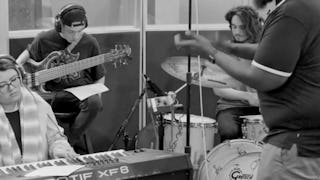Apprenez les concepts de base de l'improvisation avec Gary Burton, l'un des improvisateurs les plus renommés du monde du jazz, y compris les processus mentaux, mélodiques et harmoniques qui contribuent aux compétences instinctives qu'un improvisateur met en œuvre lorsqu'il prend un solo. Alors que de nombreuses personnes sont fans de jazz et comprennent que les musiciens "inventent" souvent les notes qu'ils jouent pendant une performance, la plupart des gens - y compris souvent les musiciens eux-mêmes, qui commencent à apprendre l'improvisation - ne comprennent pas clairement quels processus exacts se produisent pour permettre à cela de se produire. L'objectif de ce cours est de présenter les concepts de base de l'improvisation moderne et la manière de maîtriser les différentes compétences musicales et mentales impliquées.

Cultivez votre carrière grâce à des programmes dirigés par des experts, des certificats prêts à l'emploi et des moyens d'évoluer sur 10 000 . Le tout pour 25 $US/mois, facturé annuellement. Économisez


Improvisation jazz
Ce cours fait partie de Spécialisation Éducation musicale pour les enseignants

Instructeur : Gary Burton
72 640 déjà inscrits
Inclus avec 
(786 avis)
Expérience recommandée
Ce que vous apprendrez
Utilisez la narration comme outil pour améliorer votre improvisation
Pratiquez et utilisez différentes gammes pour améliorer vos capacités d'improvisation
Identifier le mouvement harmonique dans une chanson
Utilisez des tons guides et des lignes de tons guides lorsque vous improvisez
Détails à connaître

Ajouter à votre profil LinkedIn
9 devoirs
Découvrez comment les employés des entreprises prestigieuses maîtrisent des compétences recherchées

Élaborez votre expertise du sujet
- Apprenez de nouveaux concepts auprès d'experts du secteur
- Acquérez une compréhension de base d'un sujet ou d'un outil
- Développez des compétences professionnelles avec des projets pratiques
- Obtenez un certificat professionnel partageable


Obtenez un certificat professionnel
Ajoutez cette qualification à votre profil LinkedIn ou à votre CV
Partagez-le sur les réseaux sociaux et dans votre évaluation de performance

Il y a 6 modules dans ce cours
Bienvenue au cours ! Nous vous présentons ici tous les détails du cours et ce que vous devez savoir pour tirer le meilleur parti de votre expérience.
Inclus
3 vidéos3 lectures1 devoir
Étant donné que chaque participant à ce cours part d'un point différent en termes d'expérience en tant qu'improvisateur, il est important d'aborder d'abord certains éléments de base. Nous commencerons notre voyage en explorant le langage utilisé par les improvisateurs de jazz. L'improvisation est analogue au langage à bien des égards. En musique, on parle couramment lorsque le vocabulaire (gammes et accords) et la grammaire (progressions harmoniques) sont assimilés à un contenu conversationnel ou à une histoire (thèmes mélodiques et structure) et que l'on n'a plus besoin d'y penser consciemment pendant que l'on joue.
Inclus
4 vidéos1 lecture1 devoir1 évaluation par les pairs1 sujet de discussion
Dans cette leçon, nous explorerons le jargon de l'improvisateur. Nous identifierons les gammes d'accords les plus courantes et le type d'harmonie auquel elles se rapportent, notamment la majeure, la mineure et la dominante 7.
Inclus
6 vidéos3 lectures2 devoirs1 évaluation par les pairs1 sujet de discussion
Les improvisateurs doivent être capables de se souvenir rapidement des gammes d'accords et de les utiliser avec fluidité. Cela devient important lorsqu'il s'agit de choisir la gamme d'accords à utiliser pour une harmonie donnée - une autre chose que nous devons être capables de déterminer immédiatement. Lorsqu'un nouvel air vous est proposé lors d'une session ou d'une répétition, vous n'avez pas le temps d'emporter la musique chez vous et de passer une heure ou deux à travailler les bonnes gammes. Les improvisateurs ont besoin d'un moyen rapide et surtout intuitif de faire ces choix de gammes en temps réel, pendant que la mélodie est jouée. Cette semaine, nous allons explorer ma méthode pour prendre ces décisions musicales rapides.
Inclus
7 vidéos2 devoirs1 évaluation par les pairs1 sujet de discussion
Il est important pour un improvisateur d'impliquer clairement les harmonies lorsqu'il improvise. Il ne suffit pas de jouer des notes correctes sur chaque accord. Dans cette leçon, nous examinerons comment l'improvisateur aide les harmonies à bouger. Une partie du travail de l'improvisateur consiste à aider l'auditeur à suivre les changements lorsque les accords passent de l'un à l'autre.
Inclus
5 vidéos1 lecture2 devoirs1 évaluation par les pairs1 sujet de discussion
Cette semaine, nous allons voir comment l'improvisateur développe des thèmes mélodiques dans un solo. Comme nous l'avons mentionné dans la première semaine, il existe des comparaisons naturelles entre la parole et l'improvisation qui illustrent ce fonctionnement. La technique la plus courante pour raconter une histoire musicale qui capte l'attention de l'auditeur pendant toute la durée de votre solo consiste à utiliser un concept traditionnel appelé thème et variation. En d'autres termes, vous introduisez un thème - une phrase musicale - puis vous le répétez, en y apportant des variations pour développer une intrigue intéressante. Un bon solo est comme une explication ou une bonne histoire. L'explication ou l'histoire est le contenu de l'improvisation.
Inclus
8 vidéos1 lecture1 devoir1 évaluation par les pairs
Instructeur

Offert par
Recommandé si vous êtes intéressé(e) par Musique et art


Berklee


Berklee


University of Rochester


Berklee
Pour quelles raisons les étudiants sur Coursera nous choisissent-ils pour leur carrière ?




Avis des étudiants
786 avis
- 5 stars
86,36 %
- 4 stars
10,95 %
- 3 stars
1,65 %
- 2 stars
0,63 %
- 1 star
0,38 %
Affichage de 3 sur 786
Révisé le 19 juin 2022
Great course. I starting the course while on vacation in Hawaii. I could wait to finish. The projects were a great way to reinforce the subject matter.
Révisé le 17 avr. 2016
Kinda have to learn to Improvise yourself, he teaches you tricks to make it better, but not *how* to improvise. However, it's impossible to generally state how to improvise, you just eventually learn.
Révisé le 29 déc. 2015
I really loved taking this extremely inspiring and informative course. Gary Burton is a fabulous instructor. I learned so much. Really wonderful. Thank you. ~ Lisa Lukas

Ouvrez de nouvelles portes avec Coursera Plus
Accès illimité à 10,000+ cours de niveau international, projets pratiques et programmes de certification prêts à l'emploi - tous inclus dans votre abonnement.
Faites progresser votre carrière avec un diplôme en ligne
Obtenez un diplôme auprès d’universités de renommée mondiale - 100 % en ligne
Rejoignez plus de 3 400 entreprises mondiales qui ont choisi Coursera pour les affaires
Améliorez les compétences de vos employés pour exceller dans l’économie numérique
Foire Aux Questions
Oui. Les apprenants doivent avoir une connaissance de base d'un instrument avant de s'inscrire à ce cours.
Bien qu'une connaissance préalable des concepts de théorie musicale ne soit pas requise pour l'inscription, il serait utile que vous ayez une connaissance pratique des concepts de base, tels que les signatures de clé, les gammes d'accords, le cercle des 5èmes, etc. Si vous pensez avoir besoin de revoir ces concepts avant de vous inscrire à Jazz Improvisation, nous vous recommandons de vous inscrire d'abord à notre cours Developing Your Musicianship offert sur Coursera.
L'accès aux cours et aux devoirs dépend de votre type d'inscription. Si vous suivez un cours en mode audit, vous pourrez consulter gratuitement la plupart des supports de cours. Pour accéder aux devoirs notés et obtenir un certificat, vous devrez acheter l'expérience de certificat, pendant ou après votre audit. Si vous ne voyez pas l'option d'audit :
Il se peut que le cours ne propose pas d'option d'audit. Vous pouvez essayer un essai gratuit ou demander une aide financière.
Le cours peut proposer l'option "Cours complet, pas de certificat" à la place. Cette option vous permet de consulter tous les supports de cours, de soumettre les évaluations requises et d'obtenir une note finale. Cela signifie également que vous ne pourrez pas acheter un certificat d'expérience.
Plus de questions
Aide financière disponible,

